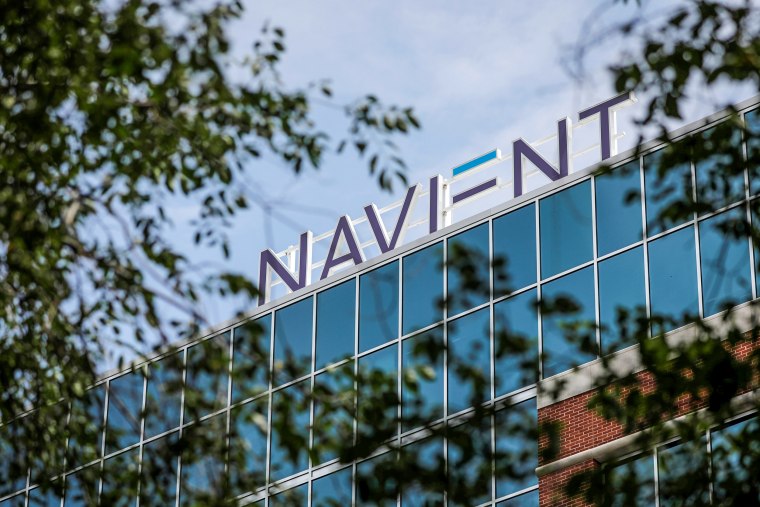Student borrowers who took out loans that were serviced by Navient, one of the largest student loan collection companies in the country, were cautiously celebrating Thursday's announcement that tens of thousands of them would get their loans canceled under an agreement with more than three dozen states.
The total amount of debt to be canceled, as well as an accompanying restitution agreement, is major — a deal worth about $1.85 billion.
A bipartisan coalition of state attorneys general are calling the resolution "a victory for student loan borrowers" in holding Navient accountable, after suing the company for allegedly misleading borrowers with deceptive lending practices and offering risky subprime loans. For its part, Navient is denying it violated consumer protection laws or caused borrowers harm, insisting it is settling the agreement "to avoid the additional burden, expense, time and distraction to prevail in court."
But for the average Navient customer hoping for immediate relief, they may be left disappointed, said Mike Pierce, executive director of the Student Borrower Protection Center, a consumer advocacy group.
"Yesterday was a very big deal for certain people that have really been forgotten in our national conversation in the student debt crisis," Pierce said. "This will be life-changing for a specific group of those people. But for everyone else, the fight continues."
Who qualifies for debt cancellation?
About 66,000 student borrowers with Navient loans may see their debts forgiven.
These are borrowers with private loans — specifically, subprime student loans taken out through Navient's predecessor company, Sallie Mae, between 2002 and 2014. (Navient was formed in 2014 after Sallie Mae split into two business entities.)
In addition, those borrowers must have had more than seven consecutive months of delinquent payments prior to June 30, 2021.
Student borrowers who don't have subprime loans may still qualify if their private loans were made between 2002 and 2014 and they attended a for-profit school that was later the subject of state or federal law enforcement actions. Those schools include Corinthian Colleges, DeVry University and ITT Educational Services. A full list can be found on a website for the agreement.
Who qualifies for a restitution payment?
About 350,000 federal student loan borrowers whom Navient placed into a long-term forbearance plan would be eligible for a payment — about $260 per borrower.
State attorneys general say those forbearance arrangements had driven student borrowers further into debt because while those borrowers were able to pause or reduce their payments temporarily, their loans still continued to accrue interest.
Certain conditions apply to get the restitution, such as having at least one federal loan that was eligible for income-driven repayment and the borrower not having enrolled in income-driven repayment prior to the forbearance period.
Borrowers whose federal loans were recently transferred to another servicer, Aidvantage, may still be eligible for restitution.
Which states were involved in the settlement?
Qualifying residents of the following states will be covered under the restitution agreement: Arizona, California, Colorado, Connecticut, Delaware, Florida, Georgia, Hawaii, Illinois, Indiana, Iowa, Kentucky, Louisiana, Maine, Maryland, Massachusetts, Minnesota, Missouri, Nebraska, Nevada, New Jersey, New Mexico, New York, North Carolina, Ohio, Oregon, Pennsylvania, Tennessee, Virginia, Washington and Wisconsin. Washington, D.C., is also included.
In addition, borrowers who qualify for debt cancellation must also reside in one of the aforementioned states or in the following states: Arkansas, Kansas, Michigan, Rhode Island, South Carolina, Vermont and West Virginia.
What actions should borrowers take?
If a borrower qualifies for either debt cancellation or a restitution payment, they will be contacted directly.
A settlement administrator is expected to send those borrowers a postcard in the mail this spring, and checks would go out in mid-2022.
For those borrowers who are set to get their private loans forgiven, they would be contacted in writing by July 2022.
The agreement among Navient and the states is still awaiting final court approval.
In the meantime, should borrowers keep paying off their loans?
Pierce recommends borrowers with private loans to keep paying or, if they can, consult an attorney about their situation.
Those with federal students loans are still benefiting from a moratorium on such payments through May 1, after the Biden administration extended the pause last month.
But there is permanent good news for those whose debt is forgiven, including under this latest settlement agreement with Navient, Pierce said.
Student loan forgiveness is tax-free as part of the White House's coronavirus stimulus package signed into law last year. Previously, any student loan debt canceled by the government was taxable.

